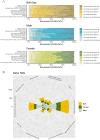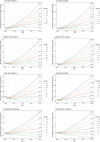Projected epidemiological trends and burden of liver cancer by 2040 based on GBD, CI5plus, and WHO data
- PMID: 39548154
- PMCID: PMC11568312
- DOI: 10.1038/s41598-024-77658-2
Projected epidemiological trends and burden of liver cancer by 2040 based on GBD, CI5plus, and WHO data
Abstract
Incidence of liver cancer as one of the most common cancers worldwide and become the significant contributor for the mortality among cancer patients. The disease burden, risk factors, and trends in incidence and mortality of liver cancer globally was described subsequently estimated the projections of liver cancer incidence or mortality by 2040. Data regarding age-standardized incidence and mortality rates for liver cancer was obtained from multiple databases, including GLOBOCAN 2020, CI5 volumes I-XI, WHO mortality database, and Global Burden of Disease (GBD)-2019. Concentrating on worldwide variations, this thorough analysis offers insights into patterns of incidence and mortality based on gender and age. Our findings encompass significant indicators, including age-standardized rates (ASRs), average annual percentage change (AAPC), and future projections extending up to the year 2040. Liver cancer holds the sixth position in terms of most frequently diagnosed cancers and stands as the sixth leading cause of cancer-related deaths worldwide in 2020, accounting for 905,677 new cases and 782,000 fatalities. Additionally, liver cancer contributed to 12,528,421 age-standardized disability-adjusted life years (DALYs), with an age-standardized DALYs rate of 161.92 in 2019 worldwide. The age-specific incidence rates exhibited significant variations across different regions, showing a fivefold difference in males and females. A significant increase in incidence was observed in North Europe and Asia, while North African countries reported a higher mortality burden (ASR, 10 per 100,000) compared to developed countries. Since last few years, the incidence and mortality rates have increased and attained Annual Average Percentage Change (AAPC) incidence rate of 7.7 (95% CI 3.9-11.6) for men and the highest AAPC mortality rate of 12.2 (95% CI 9.5-15.0) for women. In 2019, Western Europe emerged as the high-risk region for DALYs related to smoking and alcohol consumption, while high-income North America carried a high risk for DALYs associated with a high body-mass index. The projected trend indicates a surge in new liver cancer incident cases, expected to rise from around 905,347 to an estimated 1,392,474 by 2040. This study described the evidence pertinent to higher incidence trends in liver cancer, particularly among both young and older adults, encompassing males and females, as well as those who are HIV-infected and HBsAg positive. A significant rise in the young population poses a significant public health concern that warrants attention from healthcare professionals to prioritize the promotion of health awareness and the development of effective cancer prevention strategies, particularly in many developing countries.
Keywords: 2040 Projections rates; Age standardized mortality rate; CI5 volumes I–XI; GBD database; Gender; HDI; Liver cancer; WHO database.
© 2024. The Author(s).
Conflict of interest statement
Figures










References
-
- Bray, F. et al. Global cancer statistics 2018: GLOBOCAN estimates of incidence and mortality worldwide for 36 cancers in 185 countries. CA Cancer J. Clin.68(6), 394–424 (2018). - PubMed
-
- Brown, R. S. Jr. & Lake, J. R. The survival impact of liver transplantation in the MELD era, and the future for organ allocation and distribution. Am. J. Transplant.5(2), 203–204 (2005). - PubMed
MeSH terms
LinkOut - more resources
Full Text Sources
Medical

